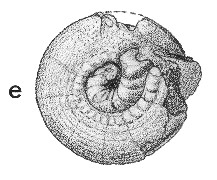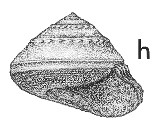
Revised descriptions of New Zealand Cenozoic Mollusca from Beu and Maxwell (1990)

 | Revised descriptions of New Zealand Cenozoic Mollusca from Beu and Maxwell (1990) | 
|
  (Pl. 36e): holotype (TM2728; Pl. 36h) and paratype (Pl. 36e), GS8074, Y17/f7683, Urumatai Stream, off Kanakanaia Rd, Te Karaka, Gisborne, Opoitian (GNS) |
  (Pl. 36h): holotype (TM2728; Pl. 36h) and paratype (Pl. 36e), GS8074, Y17/f7683, Urumatai Stream, off Kanakanaia Rd, Te Karaka, Gisborne, Opoitian (GNS) |
Beu & Maxwell (1990): Chapter 14; p. 289; pl. 36 e,h.
Synonymy: Zethalia russelli Marwick 1965, p. 27
Classification: Trochidae: Umboniinae
Description: Very small for genus (6-7 mm in diameter, 4.5-5 mm high), depressed conical, with low spire; base slightly convex, narrowly umbilicate. Spire outline almost straight. Sculpture of 2 very narrow, closely spaced, low spiral cords forming a narrow, biangled periphery; a row of low, rounded beads below suture down whole shell; many very fine, low, closely spaced spiral threads on base; a row of low, closely spaced beads bordering narrow umbilicus (which is a third diameter of base), and a large, beaded spiral ridge within umbilicus (formed by a callused columellar lobe of inner lip), leaving a narrowly open central umbilical tube.
Comparison: The evolution of Zethalia was discussed by Marwick (1965, p. 27-28). Z. russelli is similar to an unnamed, partially coeval species of Antisolarium in Birch's Mill shellbed, Te Waewae Bay (early Opoitian) in size, shape, and most sculpture, but the Antisolarium species has a much more widely open, deeper umbilicus and a third spiral cord above the periphery. The unnamed Antisolarium appears to have been ancestral to A. stoliczkai (Opoitian-Waipipian); A. stoliczkai has more spiral cords and no subsutural beads. The unnamed Opoitian Antisolarium, or a similar species, was also thought likely by Marwick (1965) to have been ancestral to Z. russelli. Zethalia evolved independently in New Zealand and is only superficially similar to Umbonium. The succeeding species Z. coronata (Waipipian-Mangapanian; early Nukumaruan?) is much larger (almost as large as Z. zelandica; up to 17 mm in diameter), has the biangulate periphery and subsutural nodules of Z. russelli, but has a much more widely callused, almost filled umbilicus. It is succeeded in turn by the Nukumaruan-Recent species Z. zelandica (Pl. 471, p), with a smooth subsuture and an obliterated umbilicus. All these behave as typical Umboniidae, with elaborate calluses on the base and in the umbilicus formed by lobes of the inner lip, and (judged by Z. zelandica) lived gregariously in huge numbers in the wave zone of sandy beaches.
Distribution: Opoitian; Urumatai Stream, near Te Karaka, Gisborne (type), abundant in concentrated Zethalia beds in shallow-water sandstone; localities are uncommon (but specimens always abundant when found) on the Napier-Taihape Road, in northern Hawke's Bay and in the Gisborne district.
Cite this publication as: "A.G. Beu and J.I. Raine (2009). Revised
descriptions of New Zealand Cenozoic Mollusca from Beu and Maxwell (1990). GNS
Science miscellaneous series no. 27."
© GNS Science, 2009
ISBN
978-0-478-19705-1
ISSN 1177-2441
(Included with a PDF facsimile file
copy of New Zealand Geological Survey Paleontological Bulletin 58 in CD version
from: Publications Officer, GNS Science, P.O. Box 30368 Lower Hutt, New
Zealand)